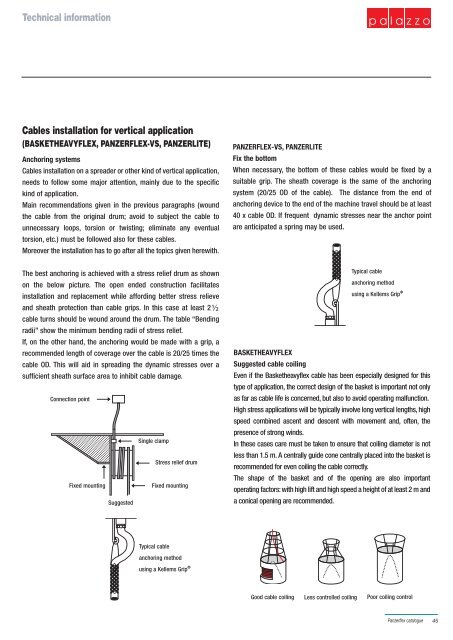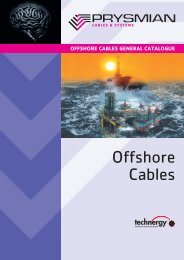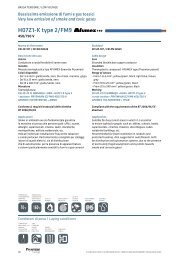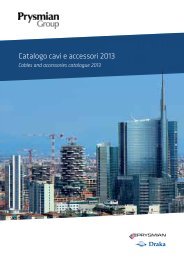panzerflex cables - Prysmian
panzerflex cables - Prysmian
panzerflex cables - Prysmian
Create successful ePaper yourself
Turn your PDF publications into a flip-book with our unique Google optimized e-Paper software.
Technical information<br />
pal<br />
azzo<br />
Cables installation for vertical application<br />
(BASKETHEAVYFLEX, PANZERFLEX-VS, PANZERLITE)<br />
Anchoring systems<br />
Cables installation on a spreader or other kind of vertical application,<br />
needs to follow some major attention, mainly due to the specific<br />
kind of application.<br />
Main recommendations given in the previous paragraphs (wound<br />
the cable from the original drum; avoid to subject the cable to<br />
unnecessary loops, torsion or twisting; eliminate any eventual<br />
torsion, etc.) must be followed also for these <strong>cables</strong>.<br />
Moreover the installation has to go after all the topics given herewith.<br />
The best anchoring is achieved with a stress relief drum as shown<br />
on the below picture. The open ended construction facilitates<br />
installation and replacement while affording better stress relieve<br />
and sheath protection than cable grips. In this case at least 2½<br />
cable turns should be wound around the drum. The table “Bending<br />
radii” show the minimum bending radii of stress relief.<br />
If, on the other hand, the anchoring would be made with a grip, a<br />
recommended length of coverage over the cable is 20/25 times the<br />
cable OD. This will aid in spreading the dynamic stresses over a<br />
sufficient sheath surface area to inhibit cable damage.<br />
Connection point<br />
Fixed mounting<br />
Suggested<br />
Single clamp<br />
Stress relief drum<br />
Fixed mounting<br />
PANZERFLEX-VS, PANZERLITE<br />
Fix the bottom<br />
When necessary, the bottom of these <strong>cables</strong> would be fixed by a<br />
suitable grip. The sheath coverage is the same of the anchoring<br />
system (20/25 OD of the cable). The distance from the end of<br />
anchoring device to the end of the machine travel should be at least<br />
40 x cable OD. If frequent dynamic stresses near the anchor point<br />
are anticipated a spring may be used.<br />
Typical cable<br />
anchoring method<br />
using a Kellems Grip ®<br />
BASKETHEAVYFLEX<br />
Suggested cable coiling<br />
Even if the Basketheavyflex cable has been especially designed for this<br />
type of application, the correct design of the basket is important not only<br />
as far as cable life is concerned, but also to avoid operating malfunction.<br />
High stress applications will be typically involve long vertical lengths, high<br />
speed combined ascent and descent with movement and, often, the<br />
presence of strong winds.<br />
In these cases care must be taken to ensure that coiling diameter is not<br />
less than 1.5 m. A centrally guide cone centrally placed into the basket is<br />
recommended for even coiling the cable correctly.<br />
The shape of the basket and of the opening are also important<br />
operating factors: with high lift and high speed a height of at least 2 m and<br />
a conical opening are recommended.<br />
Typical cable<br />
anchoring method<br />
using a Kellems Grip ®<br />
Good cable coiling Less controlled coiling Poor coiling control<br />
Panzerflex catalogue<br />
45

















